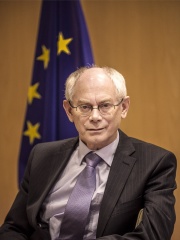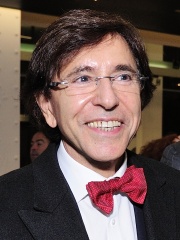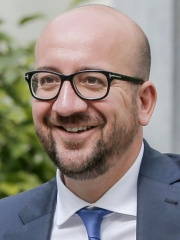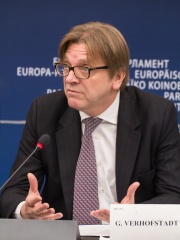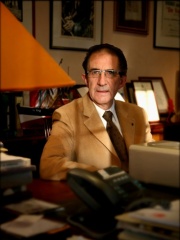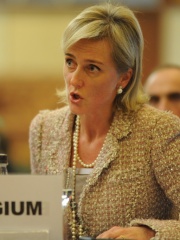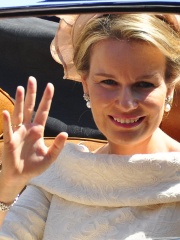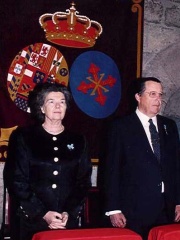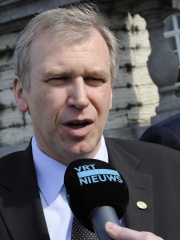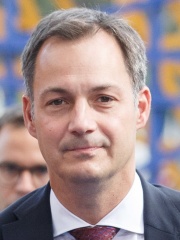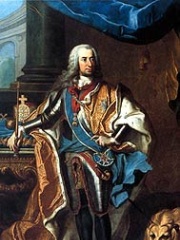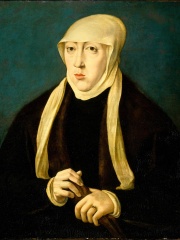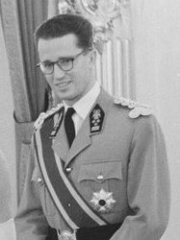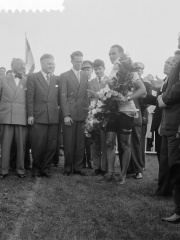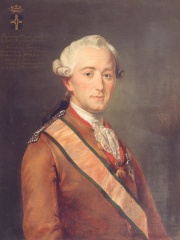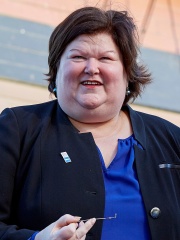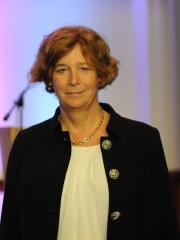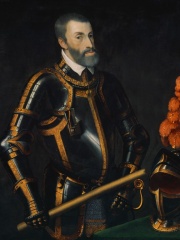
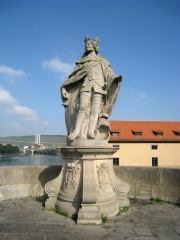
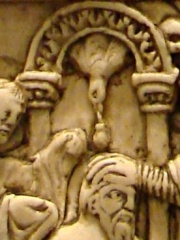
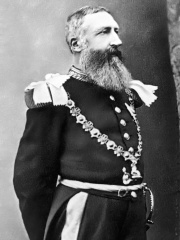
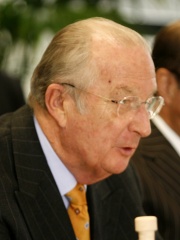
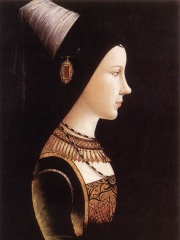
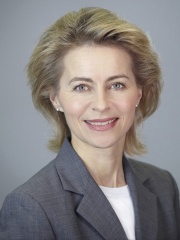
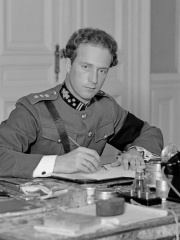
The Most Famous
POLITICIANS from Belgium
This page contains a list of the greatest Belgian Politicians. The pantheon dataset contains 15,577 Politicians, 140 of which were born in Belgium. This makes Belgium the birth place of the 25th most number of Politicians behind Netherlands and Czechia.
Top 10
The following people are considered by Pantheon to be the top 10 most legendary Belgian Politicians of all time. This list of famous Belgian Politicians is sorted by HPI (Historical Popularity Index), a metric that aggregates information on a biography’s online popularity. Visit the rankings page to view the entire list of Belgian Politicians.

1. Charles V, Holy Roman Emperor (1500 - 1558)
With an HPI of 85.01, Charles V, Holy Roman Emperor is the most famous Belgian Politician. His biography has been translated into 97 different languages on wikipedia.
Charles V (24 February 1500 – 21 September 1558) was Holy Roman Emperor and Archduke of Austria from 1519 to 1556, King of Spain from 1516 to 1556, and Lord of the Netherlands as titular Duke of Burgundy from 1506 to 1555. He was heir to and then head of the rising House of Habsburg. His dominions in Europe included the Holy Roman Empire, extending from Germany to northern Italy with rule over the Austrian hereditary lands and Burgundian Low Countries, and Spain with its possessions of the southern Italian kingdoms of Naples, Sicily and Sardinia. In the Americas, he oversaw the continuation of Spanish colonization and a short-lived German colonization. The personal union of the European and American territories he ruled was the first collection of realms labelled "the empire on which the sun never sets". Charles was born in Flanders to Habsburg Archduke Philip the Handsome, son of Emperor Maximilian I and Mary of Burgundy, and Joanna of Castile, younger child of Isabella I of Castile and Ferdinand II of Aragon, the Catholic Monarchs of Spain. Heir of his grandparents, Charles inherited his family dominions at a young age. After his father's death in 1506, he inherited the Low Countries. In 1516 he became King of Spain as co-monarch of Castile and Aragon with his mother. Spain's possessions included the Castilian colonies of the West Indies and the Spanish Main, as well as Naples, Sicily, and Sardinia. At the death of his grandfather Maximilian in 1519, he inherited the Austrian hereditary lands and was elected as Holy Roman Emperor. He adopted the Imperial name of Charles V as his main title, and styled himself as a new Charlemagne. Charles revitalized the medieval concept of universal monarchy. With no fixed capital, he made 40 journeys through the different entities he ruled and spent a quarter of his reign travelling within his realms. Although his empire came to him peacefully, he spent most of his life waging war, exhausting his revenues and leaving debts in his attempt to defend the integrity of the Holy Roman Empire from the Reformation, the expansion of the Ottoman Empire, and in wars with France. Charles borrowed money from German and Italian bankers and, to repay them, relied on the wealth of the Low Countries and on flow of silver from New Spain and Peru, brought under his rule following the Spanish conquest of the Aztec and Inca empires, which caused widespread inflation. Crowned King in Germany, Charles sided with Pope Leo X and declared Martin Luther an outlaw at the Diet of Worms (1521). The same year, Francis I of France, surrounded by the Habsburg possessions, started a war in Italy that led to the Battle of Pavia. The Protestant affair re-emerged in 1527 as Rome was sacked by an army of Charles's mutinous soldiers, largely of Lutheran faith. Charles then defended Vienna from the Turks and obtained a coronation as King of Italy and Holy Roman Emperor from Pope Clement VII. In 1535, he took possession of Milan and captured Tunis. However, the loss of Buda during the struggle for Hungary and the Algiers expedition in the early 1540s frustrated his anti-Ottoman policies. After years of negotiations, Charles V came to an agreement with Pope Paul III for the organization of the Council of Trent (1545). The refusal of the Lutheran Schmalkaldic League to recognize the council's validity led to a war, won by Charles. However, Henry II of France offered new support to the Lutheran cause and strengthened the Franco-Ottoman alliance with Suleiman the Magnificent. Ultimately, Charles V conceded the Peace of Augsburg and abandoned his multi-national project with abdications in 1556 that divided his hereditary and imperial domains between the Spanish Habsburgs, headed by his son Philip II of Spain, and Austrian Habsburgs, headed by his brother Ferdinand. In 1557, Charles retired to the Monastery of Yuste in Extremadura and died there a year later.

2. Pepin the Short (715 - 768)
With an HPI of 80.80, Pepin the Short is the 2nd most famous Belgian Politician. His biography has been translated into 76 different languages.
Pepin the Short (Latin: Pipinus; French: Pépin le Bref; c. 714 – 24 September 768), was King of the Franks from 751 until his death in 768. He was the first Carolingian to become king. Pepin was the son of the Frankish prince Charles Martel and his wife Rotrude. Pepin's upbringing was distinguished by the ecclesiastical education he had received from the Christian monks of the Abbey Church of St. Denis, near Paris. Succeeding his father as the Mayor of the Palace in 741, Pepin reigned over Francia jointly with his elder brother, Carloman. Pepin ruled in Neustria, Burgundy, and Provence, while his older brother Carloman established himself in Austrasia, Alemannia, and Thuringia. The brothers were active in suppressing revolts led by the Bavarians, Aquitanians, Saxons, and the Alemanni in the early years of their reign. In 743, they ended the Frankish Interregnum by choosing Childeric III, who was to be the last Merovingian monarch, as figurehead King of the Franks. Being well disposed towards the Christian Church and Papacy on account of their ecclesiastical upbringing, Pepin and Carloman continued their father's work in supporting Saint Boniface in reforming the Frankish church and evangelizing the Saxons. After Carloman, an intensely pious man, retired to religious life in 747, Pepin became the sole ruler of the Franks. He suppressed a revolt led by his half-brother Grifo and succeeded in becoming the undisputed master of all Francia. Giving up pretense, Pepin then forced Childeric into a monastery and had himself proclaimed King of the Franks with the support of Pope Zachary in 751. Not all members of the Carolingian family supported the decision, and Pepin had to put down a revolt led by Carloman's son, Drogo, and again by Grifo. As King of the Franks, Pepin embarked on an ambitious program to expand his power. He reformed the Franks' legislation and continued Boniface's ecclesiastical reforms. Pepin also intervened in favour of the Papacy of Stephen II against the Lombards in Italy. In the midsummer of 754, Stephen II anointed Pepin afresh, together with his two sons, Charles and Carloman. The ceremony took place in the Abbey Church of St. Denis, and the Pope formally forbade the Franks ever to elect as king anyone who was not of the sacred race of Pepin. He also bestowed upon Pepin and his sons the title of Patrician of Rome. Pepin was able to secure several cities, which he then gave to the Pope as part of the Donation of Pepin. This formed the legal basis for the Papal States in the Middle Ages. The Byzantine Greeks, keen to make good relations with the growing power of the Frankish Empire, gave Pepin the title of Patricius. In wars of expansion for the Frankish realm, Pepin conquered Septimania from the Umayyad and Andalusian Muslims and defeated them at the siege of Narbonne in 759, and proceeded to subjugate the southern realms by repeatedly defeating Waiofar and his Gascon troops, after which the Gascon and Aquitanian lords saw no option but to pledge loyalty to the Franks. Pepin was, however, troubled by the relentless revolts of the Saxons and the Bavarians. He campaigned tirelessly in Germania as well, but the final subjugation of the Germanic tribes was left to his successors. Pepin died in 768 from unknown causes and was succeeded by his sons Charlemagne and Carloman. Although Pepin was unquestionably one of the most powerful and successful rulers of his time, his reign is largely overshadowed by that of his more famous son, Charlemagne.

3. Clovis I (466 - 511)
With an HPI of 80.67, Clovis I is the 3rd most famous Belgian Politician. His biography has been translated into 82 different languages.
Clovis (Latin: Chlodovechus; reconstructed Frankish: *Hlodowig; c. 466 – 27 November 511) was the first king of the Franks to unite all of the Frankish tribes under one ruler, changing the form of leadership from a group of petty kings to rule by a single king and ensuring that the kingship was passed down to his heirs. He is considered to have been the founder of the Merovingian dynasty, which ruled the Frankish kingdom for the next two centuries. Clovis is important in the historiography of France as "the first king of what would become France". Clovis succeeded his father, Childeric I, as a king of the Salian Franks in 481, and eventually came to rule an area extending from what is now the southern Netherlands to northern France, corresponding in Roman terms to Gallia Belgica (northern Gaul). At the Battle of Soissons (486) he established his military dominance of the rump state of the fragmenting Western Roman Empire which was then under the command of Syagrius. By the time of his death in 511, Clovis had conquered several smaller Frankish kingdoms in the northeast of Gaul including some northern parts of what is now France. Clovis also conquered the Alemanni tribes in eastern Gaul, and the Visigothic kingdom of Aquitania in the southwest. These campaigns added significantly to Clovis's domains, and established his dynasty as a major political and military presence in western Europe. Clovis is also significant because of his baptism in 508, largely at the behest of his wife, Clotilde, who would later be venerated as a saint for this act, celebrated today in both the Catholic Church and Eastern Orthodox Church. The adoption by Clovis of Nicene Christianity (as opposed to the Arianism of most other Germanic tribes) led to widespread conversion among the Frankish peoples; to religious unification across what is now modern-day France, the Low Countries and Germany; three centuries later, to Charlemagne's alliance with the Bishop of Rome; and in the middle of the 10th century under Otto I the Great, to the consequent birth of the early Holy Roman Empire.

4. Leopold II of Belgium (1835 - 1909)
With an HPI of 75.64, Leopold II of Belgium is the 4th most famous Belgian Politician. His biography has been translated into 76 different languages.
Leopold II (French: Léopold Louis Philippe Marie Victor; Dutch: Leopold Lodewijk Filips Maria Victor; 9 April 1835 – 17 December 1909) was the second King of the Belgians from 1865 to 1909, and the founder and sole owner of the Congo Free State from 1885 to 1908. Born in Brussels as the second but eldest-surviving son of King Leopold I and Queen Louise, Leopold succeeded his father to the Belgian throne in 1865 and reigned for 44 years until his death, the longest reign of a Belgian monarch to date. He died without surviving legitimate sons. The current Belgian king descends from his nephew and successor, Albert I. He is popularly referred to as the Builder King (Dutch: Koning-Bouwheer, French: Roi-Bâtisseur) in Belgium in reference to the great number of buildings, urban projects and public works he commissioned. Leopold was the founder and sole owner of the Congo Free State, a private project undertaken on his own behalf as a personal union with Belgium. He used Henry Morton Stanley to help him lay claim to the Congo, the present-day Democratic Republic of the Congo. At the Berlin Conference of 1884–1885, the colonial nations of Europe authorised his claim and committed the Congo Free State to him. Leopold ran the Congo by using the mercenary Force Publique for his personal gain. He extracted a fortune from the territory, initially by the collection of ivory and, after a rise in the price of natural rubber in the 1890s, by forced labour from the native population to harvest and process rubber. Leopold's administration of the Congo Free State was characterized by atrocities and systematic brutality, including forced labour, torture, murder, kidnapping, and the amputation of the hands of men, women, and children when the quota of rubber was not met. In one of the first uses of the term, George Washington Williams described the practices of Leopold's administration of the Congo Free State as "crimes against humanity" in 1890. These and other facts were established during Leopold's rule by eyewitness testimony, by on-site inspection from an international commission of inquiry, by the investigative journalism and activism of E. D. Morel, and by the 1904 Casement Report. While it has proven difficult to accurately estimate the pre-colonial population and the amount by which it changed under the Congo Free State, estimates for the Congolese population decline during Leopold's rule range from 1 million to 15 million. The causes of the decline included epidemic disease, a reduced birth rate, and violence and famine caused by the regime.: 225–233 In 1908, the reports of deaths and abuse, along with pressure from the Congo Reform Association and other international groups, induced the Belgian Government to take over the administration of the Congo from Leopold during the penultimate year of his rule. The Congo Free State was thus reconstituted as a new territory, the Belgian Congo.
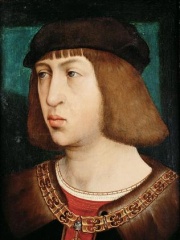
5. Philip I of Castile (1478 - 1506)
With an HPI of 75.24, Philip I of Castile is the 5th most famous Belgian Politician. His biography has been translated into 52 different languages.
Philip the Handsome (22 July 1478 – 25 September 1506), also called the Fair, was ruler of the Burgundian Netherlands and titular Duke of Burgundy from 1482 to 1506, as well as the first Habsburg King of Castile (as Philip I) for a brief time in 1506. The son of Maximilian of Austria (later Holy Roman Emperor as Maximilian I) and Mary of Burgundy, Philip was not yet four years old when his mother died as a result of a riding accident, and upon her death, he inherited the Burgundian Netherlands. Despite his young age, Philip quickly proved himself an effective ruler beloved by his people in the Low Countries, pursuing policies that favored peace and economic development, while maintaining a steady course of the government building. In 1496, Philip's father arranged for him to marry Joanna, the second daughter of Queen Isabella I of Castile and King Ferdinand II of Aragon. Around the same time, Philip's sister, Margaret, was given in marriage to Joanna's brother John, Prince of Asturias. After the deaths of her brother John, sister Isabella, and nephew Miguel, Joanna became heiress presumptive to the thrones of Castile and Aragon. Most of Philip's time in Spain was spent consolidating his power, often leading to conflicts with his wife and her father. Joanna became queen of Castile when her mother died in 1504. Philip was proclaimed king in 1506, but died a few months later, leaving his wife distraught with grief. Joanna's father, Ferdinand II of Aragon, and her own son, Charles V, Holy Roman Emperor, were quick to seize power, confining the queen for the rest of her life on account of her alleged insanity. Philip was the first Habsburg monarch in Spain, and every Spanish monarch since his son Charles V has been one of his descendants. Philip died before his father, and therefore never inherited his father's territories or became Holy Roman Emperor. However, his son Charles eventually united the Habsburg, Burgundian, Castilian, and Aragonese inheritances. By inheriting the Burgundian Netherlands and acquiring much of Spain and its possessions in the New World by marriage to Joanna, Philip was instrumental in vastly enhancing the territories of the Habsburgs, and his progeny would rule over European territories for the next five centuries.

6. Albert II of Belgium (1934 - )
With an HPI of 74.24, Albert II of Belgium is the 6th most famous Belgian Politician. His biography has been translated into 76 different languages.
Albert II (born 6 June 1934) is a member of the Belgian royal family who reigned as King of the Belgians from 9 August 1993 to 21 July 2013. Albert II is the son of King Leopold III and the last living child of Queen Astrid, born a princess of Sweden. He is the younger brother of the late Grand Duchess Joséphine-Charlotte of Luxembourg and King Baudouin, whom he succeeded following Baudouin's death in 1993. He married Donna Paola Ruffo di Calabria (now Queen Paola), with whom he had three children. Albert's eldest son, Philippe, is the current King of the Belgians. On 3 July 2013, King Albert II attended a midday session of the Belgian cabinet. He then announced that, on 21 July, Belgian National Day, he would abdicate the throne for health reasons. He was succeeded by his son Philippe on 21 July 2013. Albert II was the fourth monarch to abdicate in 2013, following Pope Benedict XVI, Queen Beatrix of the Netherlands, and Emir Hamad bin Khalifa of Qatar. In so doing, he was also the second Belgian monarch to abdicate, following his father, Leopold III, who abdicated in 1951, albeit under very different circumstances.

7. Mary of Burgundy (1457 - 1482)
With an HPI of 73.84, Mary of Burgundy is the 7th most famous Belgian Politician. Her biography has been translated into 52 different languages.
Mary of Burgundy (French: Marie de Bourgogne; Dutch: Maria van Bourgondië; 13 February 1457 – 27 March 1482), nicknamed the Rich, was a member of the House of Valois-Burgundy who ruled a collection of states that included the duchies of Limburg, Brabant, Luxembourg, the counties of Namur, Holland, Hainaut and other territories, from 1477 until her death in 1482. As the only child of Charles the Bold, Duke of Burgundy, and his wife Isabella of Bourbon, Mary inherited the Burgundian lands at the age of 19 upon the death of her father in the Battle of Nancy on 5 January 1477. In order to counter the appetite of the French king Louis XI for her lands, she married Maximilian of Austria, with whom she had two children. The marriage kept large parts of the Burgundian lands from disintegration, but also changed the dynasty from Valois to Habsburg (the Duchy of Burgundy itself soon became a French possession). This was a turning point in European politics, leading to a French–Habsburg rivalry that would endure for centuries. Long after Mary's death, her husband became Holy Roman Emperor. Their son became King Philip I of Castile, and their daughter, Margaret, became Duchess of Savoy.

8. Ursula von der Leyen (1958 - )
With an HPI of 73.69, Ursula von der Leyen is the 8th most famous Belgian Politician. Her biography has been translated into 80 different languages.
Ursula Gertrud von der Leyen (German: [ˈʊʁzula ˈɡɛʁtʁuːt fɔn deːɐ̯ ˈlaɪən] ; née Albrecht; born 8 October 1958) is a German physician and politician serving as the 13th president of the European Commission since 2019. She served in the German federal government between 2005 and 2019, holding successive positions in Angela Merkel's cabinet, most recently as federal minister of defence. Von der Leyen is a member of the centre-right Christian Democratic Union (CDU) and its EU affiliated group, the European People's Party (EPP). Ursula von der Leyen was born and raised in Brussels, Belgium, to German parents. Her father, Ernst Albrecht, was one of the first European civil servants. She was brought up bilingually in German and French, and moved to Germany in 1971 when her father became involved in German politics. She graduated from the London School of Economics in 1978, and in 1987, she acquired her medical license from Hanover Medical School. After marrying fellow physician Heiko von der Leyen, she lived for four years in the United States with her family in the 1990s. After returning to Germany she became involved in local politics in the Hanover region in the late 1990s, and she served as a cabinet minister in the state government of Lower Saxony from 2003 to 2005. In 2005, she joined the federal cabinet, first as minister of family affairs and youth from 2005 to 2009, then as minister of labour and social affairs from 2009 to 2013, and finally as minister of defence from 2013 to 2019, the first woman to serve as German defence minister. When she left office she was the only minister to have served continuously in Merkel's cabinet since Merkel became chancellor. She served as a deputy leader of the CDU from 2010 to 2019, and was regarded as a leading contender to succeed Merkel as chancellor of Germany and as the favourite to become secretary general of NATO after Jens Stoltenberg. British defence secretary Michael Fallon described her in 2019 as "a star presence" in the NATO community and "the doyenne of NATO ministers for over five years." In 2023, she was again regarded as the favourite to take the role. On 2 July 2019, von der Leyen was proposed by the European Council as the candidate for president of the European Commission. She was then elected by the European Parliament on 16 July; she took office on 1 December, becoming the first woman to hold the office. In November 2022 von der Leyen announced that her Commission would work to establish an International Criminal Tribunal for the Russian Federation. She was named the most powerful woman in the world by Forbes in 2022 and 2023.

9. Leopold III of Belgium (1901 - 1983)
With an HPI of 73.06, Leopold III of Belgium is the 9th most famous Belgian Politician. His biography has been translated into 63 different languages.
Leopold III (3 November 1901 – 25 September 1983) was King of the Belgians from 23 February 1934 until his abdication on 16 July 1951. At the outbreak of World War II, Leopold tried to maintain Belgian neutrality, but after the German invasion in May 1940, he surrendered his country, earning him much hostility, both at home and abroad. Leopold's act was declared unconstitutional by Prime Minister Hubert Pierlot and his cabinet, who moved to London to form a government-in-exile, while Leopold and his family were placed under house arrest. In 1944, they were moved to Germany and then Austria, before being liberated by the Americans, but banned for some years from returning to Belgium, where his brother Prince Charles, Count of Flanders, had been declared regent. Leopold's eventual return to his homeland in 1950 nearly caused a civil war, and under pressure from the government, he abdicated in favour of his son Baudouin in July 1951. Leopold's first wife, Astrid of Sweden, was killed in a road accident while on a driving holiday in Switzerland in August 1935, being much mourned by the public. His morganatic second marriage, to Lilian Baels in captivity in 1941, was contrary to Belgian law, which stipulates that the civil marriage has to occur before a religious marriage, and she was never permitted the title of queen.
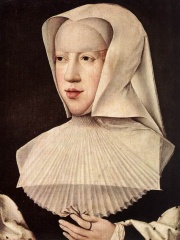
10. Margaret of Austria, Duchess of Savoy (1480 - 1530)
With an HPI of 71.82, Margaret of Austria, Duchess of Savoy is the 10th most famous Belgian Politician. Her biography has been translated into 42 different languages.
Archduchess Margaret of Austria (German: Margarete; French: Marguerite; Dutch: Margaretha; Spanish: Margarita; 10 January 1480 – 1 December 1530) was Governor of the Habsburg Netherlands from 1507 to 1515 and again from 1519 to 1530. She was the first of many female regents in the Netherlands.
Pantheon has 140 people classified as politicians born between 100 BC and 1981. Of these 140, 30 (21.43%) of them are still alive today. The most famous living politicians include Albert II of Belgium, Ursula von der Leyen, and Herman Van Rompuy. The most famous deceased politicians include Charles V, Holy Roman Emperor, Pepin the Short, and Clovis I. As of April 2022, 9 new politicians have been added to Pantheon including Prince Alexandre of Belgium, Florimond Claude, Comte de Mercy-Argenteau, and Alexander De Croo.
Living Politicians
Go to all Rankings
Albert II of Belgium
1934 - Present
HPI: 74.24
Ursula von der Leyen
1958 - Present
HPI: 73.69
Herman Van Rompuy
1947 - Present
HPI: 65.72
Elio Di Rupo
1951 - Present
HPI: 59.81
Charles Michel
1975 - Present
HPI: 59.47
Guy Verhofstadt
1953 - Present
HPI: 57.33
Willy Claes
1938 - Present
HPI: 56.84
Princess Astrid of Belgium, Archduchess of Austria-Este
1962 - Present
HPI: 56.83
Queen Mathilde of Belgium
1973 - Present
HPI: 56.62
Princess Anne, Duchess of Calabria
1938 - Present
HPI: 55.44
Yves Leterme
1960 - Present
HPI: 52.70
Alexander De Croo
1975 - Present
HPI: 52.60

Deceased Politicians
Go to all Rankings
Charles V, Holy Roman Emperor
1500 - 1558
HPI: 85.01
Pepin the Short
715 - 768
HPI: 80.80
Clovis I
466 - 511
HPI: 80.67
Leopold II of Belgium
1835 - 1909
HPI: 75.64
Philip I of Castile
1478 - 1506
HPI: 75.24
Mary of Burgundy
1457 - 1482
HPI: 73.84
Leopold III of Belgium
1901 - 1983
HPI: 73.06
Margaret of Austria, Duchess of Savoy
1480 - 1530
HPI: 71.82
Albert I of Belgium
1875 - 1934
HPI: 71.49
Charles VII, Holy Roman Emperor
1697 - 1745
HPI: 71.11
Mary of Hungary
1505 - 1558
HPI: 70.89
Baudouin of Belgium
1930 - 1993
HPI: 70.83

Newly Added Politicians (2022)
Go to all Rankings
Prince Alexandre of Belgium
1942 - 2009
HPI: 55.43
Florimond Claude, Comte de Mercy-Argenteau
1727 - 1794
HPI: 54.95
Alexander De Croo
1975 - Present
HPI: 52.60
Ludo Martens
1946 - 2011
HPI: 48.98
Reginar IV, Count of Mons
HPI: 44.89
Maggie De Block
1962 - Present
HPI: 44.04
Petra De Sutter
1963 - Present
HPI: 43.87
Ann Simons
1980 - Present
HPI: 23.75
Émilie Heymans
1981 - Present
HPI: 21.76

Which Politicians were alive at the same time? This visualization shows the lifespans of the 25 most globally memorable Politicians since 1700.

